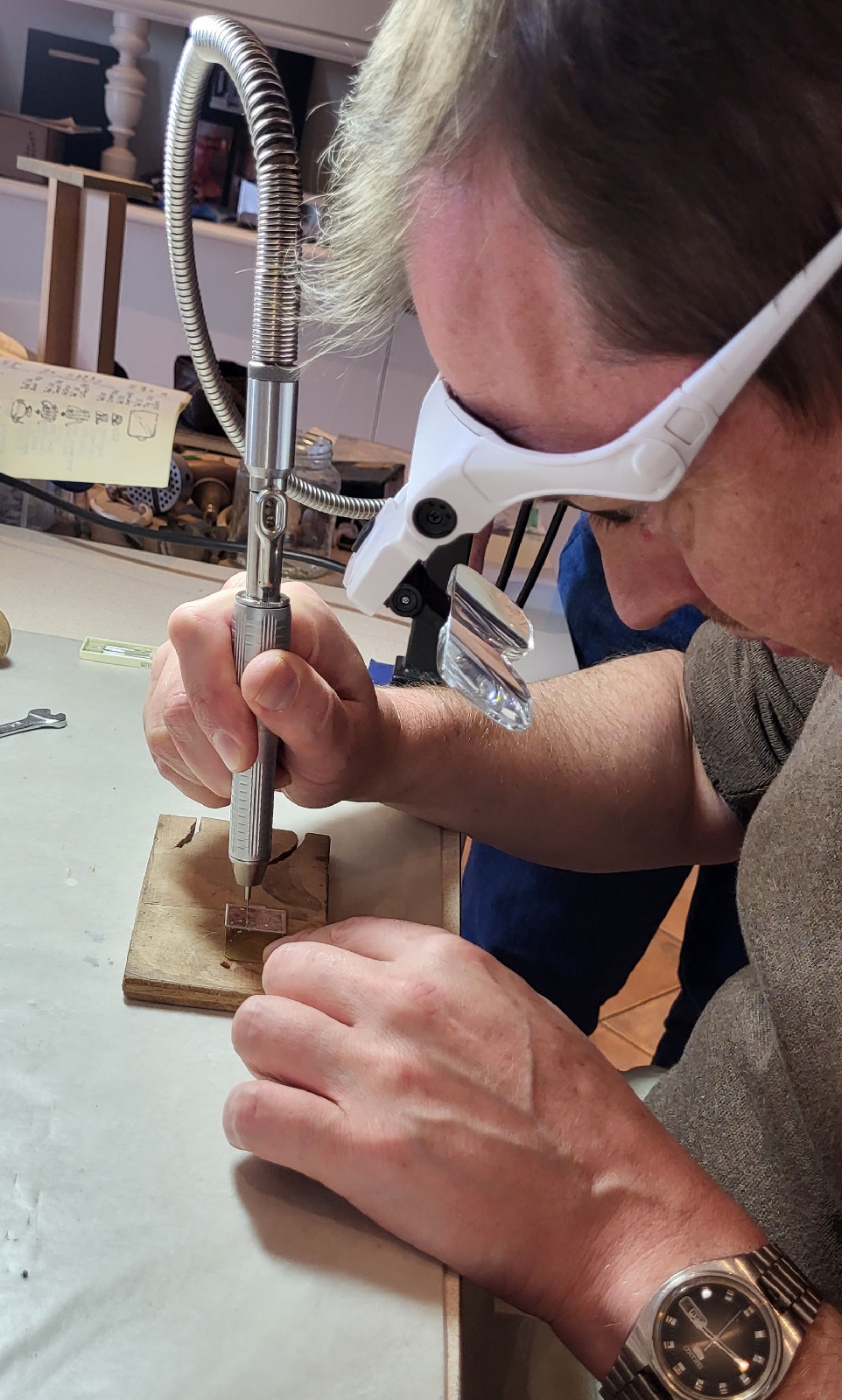The weekend after the Dollshouse Nederland Show in Arnhem I attended a silver workshop given by Jens Torp. During the three day long workshop we made silver covers for the front and back plates of a book made by Tine Krijnen. Below isva picture of the one Jens made as an example. Excuisite!
It was my first ever workshop on working with silver. I found it daunting but also very exciting to work with silver.
It started simple enough. Two small plates of silver and a brass template. Our first job was to bend and fold 3 edges over the template. Thus creating a cover to slide on the book when finished. I messed up the first one. so I got a third plate to try again. Luckily number 2 and 3 turned out ok. So, after the necessary cutting, filing and bending I had two folded plates to work with.
Next came the soldering with silver. The corners had to be soldered shut and a short stub of silver thread had to be soldered on the long side. These would become part of the clasp later. I gave soldering a try but I could not make it work. Fortunately Jens was kind enough to help me so it turned out alright in the end. Well the soldering at least. The book covers were as yet nowhere near finished, but the first day of the workshop already drew to a close.
It took me a long time to decide which designs to use. But then I could finally start opening up the little silver plates. You start by drilling holes where the silver needs to be removed. Insert the thread of the jewelers fretsaw and cut out the unwanted piece. And then you go on to the next, and the next, and the next... and so on and so forth.
When working on such a small surface with nothing but curvy lines it takes a very long time before you have finished one side. And even longer for both sides. Because the silver is thin and not as hard as brass, cutting around end pieces means that you have to saw carefully and slowly. You do not want to bend the material or damage it in any other way. So you cannot rush this stage.
When the sawing on both of my pieces was (finally) finished, the third day had already started! Now it was time for me to engrave the lines of pettals and such. This gives the design detail and depth. Great to do but hard to master. Making curved lines has been very hard to do. Stil I have a lot to practice before I have mastered this.
But if you think that was tough to do... We then had to cut away the middle section of the silver bars on the covers. Jens provided us with a ready made clasp that should go between these. But to turn this into a hinge, meant drilling through the little round bars so a thread could be pulled through. This meant drilling with a drill measuring 0.6 mm in diameter....
Luckily, Jens helped the faint of hearts... I was one of those. I am bad at drilling straight. and the margin of error is extremely small here. Next time I must try it myself, just like I will try my hand at soldering again. I must be able to master it in the near future.
And here you can see the holes cut by Jens, turning the small silver bars into hinges. Silver thread was threaded through them and tapped with a jewelers hammer to flatten and broaden the ends so they can not fall out of the hinge.
The last task that remained now was to add a pearl trim around the decorations and polish the silver. Smoothing away the rough edges and make the silver shine again. However, I had run out of time!
Luckily, Jens wanted to help me out by adding the pearl trim. This was the third time he helped me out! I would find a way to polish the silver myself. There must be a jeweler in my area that would help me out. A friend of mine, who also attended the class, stayed the evening there and would take my bookplates home with him. We would then meet up later in the month to hand them over.
We did so while visiting Slot Zuylen, a castle near the city of Utrecht. I will show you its lovely interiors in a next post. And finally the book and the silver covers are united.
I love the result! I am very happy with them although there are a few mistakes made that remain visible. It is my first miniature silver piece. Handmade by me and aided by Jens Torp. I can assure you that it will not be my last! Hopefully next year there will be another miniature silver workshop.
There is even video footage of the workshop itself on YouTube! Josje (Make Miniatures With Josje) attended the workshop as well and made a nifty bookcover herself. You can see her vlog about the workshop here. I even have a little guest role in it! 🤭
I talked with her about a mistake I had made while engraving, unoblibious that she was shooting footage for this episode at that moment. So, if you want to hear my voice, here is your chance. 😅
Well, that is all for now. Stay safe and until my next post.
Huibrecht












































